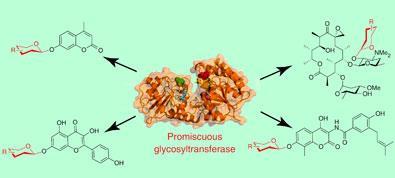A key advance in efforts to bolt sugar molecules onto natural products in the search for new drugs
Researchers in the US have made a key advance in efforts to bolt sugar molecules onto natural products in the search for new drugs. Many naturally occurring molecules with pharmacological activity are decorated with sugar residues, and by adding or changing these sugars it is possible to improve the parent compound’s pharmacological properties.
One way of adding sugars to such compounds is by using enzymes called glycosyltransferases (GTs). However, these are often highly specific to both the sugar molecule and the acceptor compound. What would be much more useful in the drug developer’s toolbox would be a smaller range of ’promiscuous’ GTs that were relatively unfussy about both the sugar and the acceptor molecule.

To this end, Gavin Williams, Changsheng Zhang and Jon Thorson at the University of Wisconsin-Madison have developed a high-throughput technique to assess the promiscuity of GTs created by ’directed evolution’ of a naturally occurring enzyme. This is achieved by creating an artificial copies of the enzyme’s gene by PCR (polymerase chain reaction) in which deliberate, random errors have been introduced. The mutated gene is then put into a microorganism, which then manufactures the mutated enzyme.
The key to screening large numbers of mutated enzymes is quickly detecting which ones work. The team were aware of a particular GT that catalyses the attachment of a sugar molecule to an acceptor called a coumarin. In its native state the coumarin is fluorescent. But when a sugar is attached, the fluorescence is quenched. ’So you can
mutate the enzyme then test a range of different sugar donors to observe if a reaction occurs,’ Thorson told Chemistry World. ’This fluorescence-based assay can easily be done on plates, allowing a large number of sugars and enzyme variants to be screened simultaneously in a high-throughput way.’
The researchers screened around 1000 mutated enzymes for activity and scored three notable hits, each of which increased the proficiency and broadened the flexibility of the enzyme. They then combined these three mutations into a single enzyme and found that this new GT was especially promiscuous - able to utilise a wide range of sugars on multiple acceptor compounds. The new enzyme would be useful for so-called glycorandomisation, the construction of libraries of compounds containing various sugar moieties that can be investigated for potential therapeutic applications.
Commenting on the work, Dianna Bowles of the University of York, UK, said: ’Glycosyltransferases offer immense potential as biocatalysts for the modification of small molecules such as natural products, antibiotics and pharmaceuticals, since the attachment of sugars is regio- and stereo-selective, and the process is far more straightforward than chemical synthesis.’
Bowles added that the research by the US group ’demonstrates the power of directed evolution - that can be applied to increase the donor and acceptor range of any glycosyltransferase: essentially increasing the promiscuity of the biocatalyst and vastly increasing its utility for glycorandomisation.’
Simon Hadlington
Enjoy this story? Spread the word using the ’tools’ menu on the left.
References
GJ Williams, C Zhang & JS Thorson, Nature Chem. Biol., 2007 (DOI: 10.1038/nchembio.2007.28)






No comments yet